After leading tours at Green-Wood for 28 years, I still love to create new ones. One of the virtues of doing new and different tours of Green-Wood: I get to research and learn. So it is with my recent tour, “Sound the Alarm: Green-Wood’s Firemen.” I knew, before I began this research, about several lots and monuments at the cemetery dedicated to firemen. However, as I prepared for this tour, I learned a great deal more. One story that has come together: that of hero Fireman William H. Nash.
A great source for information about New York City firemen is Reminiscences of the Old Fire Laddies and Volunteer Fire Departments of New York City and Brooklyn, Together with a Complete History of the Paid Departments of Both Cities (that’s quite a title!), by J. Frank Kernan, published in 1885.
Kernan devotes many pages of his 897-page tome to Nash. In addition to accounts of Nash’s heroism as a fireman, Kernan describes in detail Nash’s service as an officer in the United States Sharpshooters (also called Berdan’s Sharpshooters, after their colonel’s last name) during the Civil War. The first regiment of Sharpshooters (there would be two regiments during the Civil War), an elite unit, was organized late in 1861. Volunteers had to try out for admission, hitting a ten-inch target with ten shots from 200 yards. Here is Kernan’s relevant passage about Nash’s military service:

Nash was described as 6 feet tall with a “military air.” He lived with his wife and children in Manhattan. Kernan also details at length the particulars of Nash’s service as a fireman–his acts of heroism, his rise through the ranks to battalion chief, and ultimately his tragic death in the line of duty.
Nash joined the New York City Fire Department in 1868 and rose to battalion chief. He was awarded the Bronze Bennett Medal, the highest award for valor given to firefighters, for his actions on December 30, 1872, when, without the protection of a hose-line, he made his way to a rear bedroom, engulfed in flames, to save two children. According to Nash’s obituary in the New York Daily Tribune, he saved the lives of at least 15 New Yorkers at a series of fires during his career.
Nash died in a tragic accident on September 14, 1875 and was interred at Green-Wood three days later. As per The Last Alarm by Boucher, Urbanowicz and Melahn, on that date, Battalion Chief Nash and a detail of firemen were assigned to demonstrate to the public the latest addition to the Fire Department’s equipment: a wooden aerial ladder. As buildings got taller and taller in Manhattan, the need for a ladder that could extend upward became acute. This aerial ladder was thought to be the solution. Nash had tested the ladder at sunrise that morning, ascending to its top–and all had seemed in order. At 11:00 a.m., at the junction of East Broadway and Canal Streets in Manhattan, an expectant crowd gathered; police pushed the spectators back from the ladder to prevent injury in case of an accident. When Nash gave the other fireman the order to climb the aerial ladder, they seemed uneasy and hesitated, apparently concerned about their safety. He urged them upward, exclaiming, “Why, there’s no danger,” and himself took the lead, racing to the top. But as he reached that top, followed closely by two other firefighters, the ladder splintered and broke, apparently because of the poor spruce wood with which it had been made, the solidity of which was further undermined when the holes for the rungs were drilled. As the crowd watched in horror, the three firemen fell 98 feet to the pavement below. Nash and another fireman died instantly; a third died shortly thereafter. The five other firemen, who were on the ladder, but below the section that gave way, were uninjured.
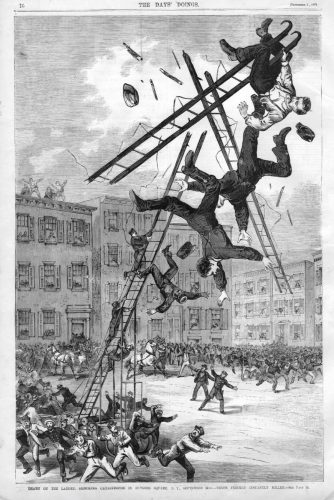
There is no question that the William H. Nash who died in the aerial ladder accident of September 14, 1875, is interred at Green-Wood. The William H. Nash who is interred at Green-Wood had died, as per cemetery records, on that same date of a “fracture of skull.”
Having worked on 5,200 Civil War-related biographies for Green-Wood’s Civil War Project on an ongoing basis for 16 years now, I was intrigued by the details of William H. Nash’s military service in Kernan’s book. I was particularly interested in his service as an officer in the United States Sharpshooters, an elite regiment. However, when I attempted to confirm Kernan’s information about Nash’s Civil War service, I ran into a problem. The best source for detailed information about the particulars of Civil War army service is the American Civil War Research Database, to which I have been a subscriber for 16 years. Here’s what I found when I searched for the officer by the name of William H. Nash who served in Berdan’s Sharpshooters:

A per the above report, the William H. Nash who served in the Sharpshooters, 1st Regiment (I checked the regimental muster roll: there was only one William H. Nash in that regiment), was born in Ohio and died on December 2, 1902. If that were correct, our hero fireman, who was born in New York City and died in 1875, could not be the William H. Nash who served as a captain in Berdan’s Sharpshooters.
But this didn’t seem right. Something was very wrong. Kernan, when he wrote his Old Fire Laddies, personally knew the men he was writing about. They were his contemporaries. And there were many others alive in New York City who knew the stories of these men. So how could Kernan have gotten so much detailed information so wrong? How could he have given Battalion Chief William H. Nash a Civil War soldier’s history that was that of another William H. Nash? Could he have made such a grievous mistake?
I decided there was only one solution to this problem: Sue Ramsey. Sue is a volunteer researcher with our Civil War Project who lives out in California. By the miracle of the Internet, she is able to work at solving our most perplexing mysteries. And she is certainly always up for a challenge. So I sent her the information: hero Fireman William H. Nash died on September 14, 1875, and was interred at Green-Wood three days later. Was he also the William H. Nash who served as a captain in Berdan’s Sharpshooters during the Civil War?
Sue plunged right in. And, within days, she was able to confirm that the information that the William H. Nash of Berdan’s Sharpshooters was born in Ohio and died in 1902 was oh so wrong–and to confirm our suspicions that the hero fireman interred at Green-Wood was also the heroic soldier.
Here’s what Sue found. The obituary in the New York Tribune of the hero fireman who is interred at Green-Wood confirms his Civil War service: “During the war he served in the army, and was several times promoted for gallantry.” The New York Times, in its obituary, lists pallbearers at his funeral who were officers in the Fire Department as well as those from the Third Army Corps Union (a fraternal organization of veterans of that corps). Notably, when Captain William H. Nash served with the United States Sharpshooters, that regiment was attached to the Third Corps of the Union’s Army of the Potomac. Additionally, the New York Herald reported on the day of his funeral that the Third Army Corps Union had passed a resolution describing the battalion chief as “our much beloved and esteemed comrade, Captain William H. Nash.” Captain was the highest rank achieved by the William H. Nash who served in the Sharpshooters; “captain” would have been an appropriate reference to his military service. Further, a delegation from the Grand Army of the Republic, the fraternal organization of Union Civil War veterans, was present at his funeral–ostensibly honoring their comrade in arms.
As Sue researched, I was able to find William H. Nash’s gravestone at Green-Wood:
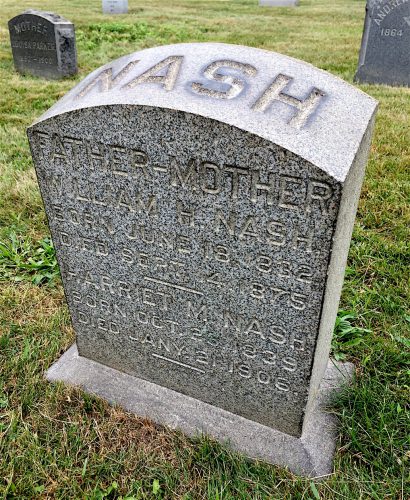
Note the name on the gravestone of William H. Nash’s wife: Harriet. And we know that the widow of the William H. Nash who served in the United States Sharpshooters was named Harriet, as is shown on this pension index card:
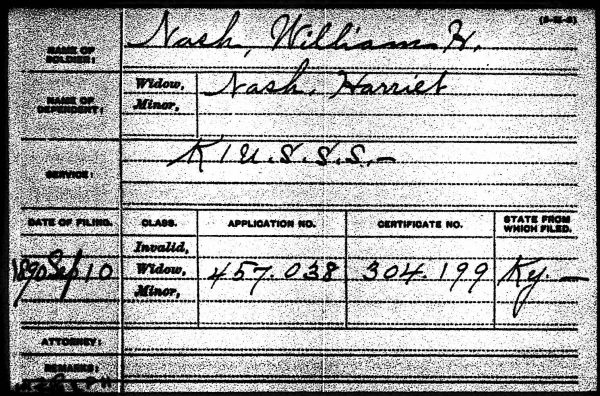
Further, the obituary for the Harriet Nash who is interred in that grave, published by the New York Herald on January 22, 1906, identifies Harriet Nash as “the wife of the late Chief of Battalion William H. Nash of New York Fire Department.”
As I researched further, I came across this photograph, on Find-A-Grave, purporting to be Battalion Chief William H. Nash:
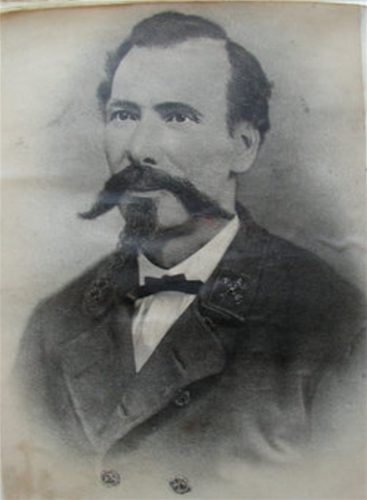
I contacted Gary Urbanowicz, leading historian of the New York Fire Department, who had posted this portrait online, asking him how he knew that this was Nash. Gary explained that he had gotten this photograph from a private collector. Gary had then checked the NYFD files and found the same photograph there with that “unmistakeable” mustache. Further, I was able to find this photograph online with what appears to me to be 19th-century handwriting on the back:
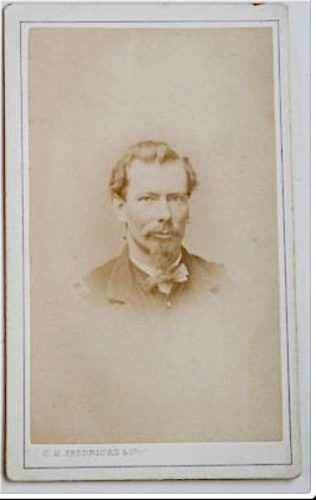

Compare the two photographs above, that of Battalion Chief William H. Nash and that of Captain William H. Nash of the United States Sharpshooters. The same man! Note the similarity of the hairlines, the shape of the heads and cheeks, the prominent brows, and the facial hair.
William H. Nash led an extraordinary life of service. He deserves to be remembered for his service to his country and his city, both in war and in peace. He should be recalled,, and honored, for his service to his community as a fireman and for making the ultimate sacrifice in the line of duty. Hopefully this blog post will give him a measure of the recognition that he so richly earned during his too-short lifetime.
Jeff, thank you for your dedication. People like Captain/Chief Nash deserve their place in history. I hope you list “Historian” in your curriculum vitae.
Thank you for your service!
Nash was a hero–both for his Civil War service and for his service as a fireman.
Yes, I am Green-Wood’s historian.
There is another William H. Nash who was in the US Sharpshooter corps during the Civil War…Wm. Harrison Nash, 1st enlistment Montville, Maine, B—26th Reg.; 2d enlistment Corp. B—1st ME. Sharpshooters